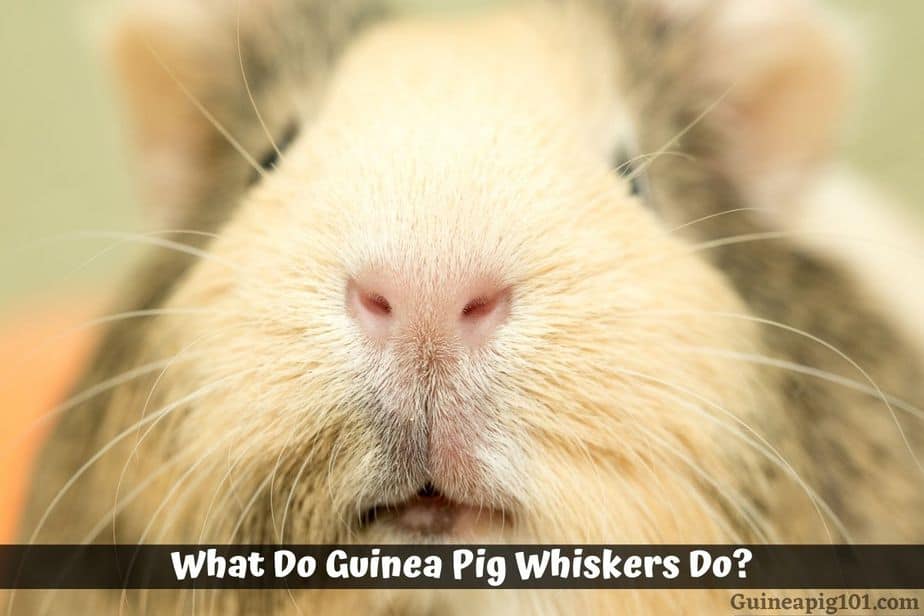Whiskers are essential sensory hair found in various animals. Guinea pigs also do have whiskers on both sides of the face. Whiskers are placed on the mouth, cheeks, nose, and above the eyes. The length of the whiskers is equal to the width of the body. Guinea pigs use their whiskers to a great extent, and it should not be cut.
Guinea pigs measure the width of the passage using their whiskers. If the end of the whiskers touches the passage, the guinea pig will not move through that path. The ends of the whiskers have sensory nerves that enable guinea pigs to know their surroundings with the correct orientation and perception.
Guinea pig’s eyes have limited depth perception ability, and it also cannot locate things very near to the body.
Guinea pigs overcome this limitation with the help of whiskers, which gives them the idea of the orientation of objects and space available to move nearby.
What do guinea pigs use their whiskers for?
Guinea pigs are blessed with an excellent sense of hearing, smell, and a wide range of vision. They also have a sense of touch.
Whiskers present on the face help them with a sense of touch. Whiskers are thick and stiff hair-like structures, which extends on both sides of the body.
Whisker follicles have sensory nerves at their end. These nerve-sense the touch of anything which the whiskers brush through.
That enables the guinea pig to feel the presence of anything nearby which the whiskers can touch.
Measuring the width of tunnels and hideouts
Guinea pigs passing through tunnels, holes, or any narrow passages measure the path’s width using its whiskers.
The sensory nerve checks whether the width is higher than the whiskers or not as the whiskers length is equal to the body width. Obese guinea pigs face problems as whiskers are designed for regular body width.
You may wonder why a guinea pig won’t enter any narrow path, it’s because of their whiskers.
Feeling nearby objects
Guinea pigs cannot focus on a nearby object to measure its depth and distance as a human can do.
Although they have a wide range of vision, they depend on their whiskers for purposes near the face.
It is fascinating to know that the entire covering of the body is covered with nerve endings. That makes them so responsive to touch.
If you approach your guinea pig from the back, they may be frightened or behave abruptly as they always fear any predator might attack them.
Navigating
Guinea pigs can move around even if they cannot see clearly due to poor lighting conditions. They use their whiskers for navigation in the dark.
Guinea pigs can find their path to escape even when you cannot see anything. They can sense the presence of any danger nearby.
Eye Protection
Whiskers are also used to a great advantage of protecting eyes. The whiskers around the eyebrows help in the protection of eyes.
They deflect any particles approaching eyes, hence safeguard eyes. They also warn against any danger or object near the head, which can damage the eyes.
Guinea pigs rely on the feedback mechanism of the touch. They not only can navigate through the house but also use the whiskers efficiently in protection.
Also read: Can guinea pigs close their eyes?
How do whiskers work in guinea pigs?
Mammals have a different type of hair called vibrissae on its body, characterized by its long length and hair follicle supplied with nerves.
These hairs are different from the usual hair found on the skin of the mammals. These hairs are associated with the touch sensory region of the brain. The brain interprets the stimulus received from these hairs.
The body or shaft of the hair is made of a protein called keratin. This same protein is found in the shaft of healthy hair.
There are no nerve cells in the shaft of the hair. So, guinea pigs do not feel any pain when you cut their whiskers.
The follicle of the whiskers is unique compared to other hairs as it contains a blood capsule. This blood capsule has sensory nerves.
You will notice the arrangement of the whiskers is well defined. The number whisker of each side of the face is the same and countable.
Whiskers are found in a large group of animals, both terrestrial and aquatic. The length is also different as per the location. The whiskers in the front are shorter compared to those at the behind.
Should I cut my guinea pigs whiskers
No, you should not try to cut or trim the whiskers of your guinea pigs.
Whiskers are supplied with more than a hundred afferent nerve cells. These nerves conduct the message to the brain.
The receptors in the brain produce the impulses in response to the stimuli received. These receptors can feel even a minute deflection. Such receptors are known as mechanoreceptors.
So, the whiskers form an essential organ of the body. They are not just natural hair, which we can cut. Without the whiskers, the movement of the guinea pigs will be affected.
How many whiskers do guinea pigs have?
Guinea pigs have whiskers on both sides of the face. Few whiskers are present on the eyebrow, above the eyes. At the same time, others are on the cheek, mouth, and also nose.
Still, guinea pigs have fewer whiskers compared to other rodents.
The movements are picked up by hundreds of motion sensors inside the vibrissae hair follicles.
Each follicle has hundreds of motion sensors. As soon as the whiskers brush on any object, the motion sensors present in the follicles intercept those movements of whiskers.
The nerves receive the information related to the location and shape of the object and decide the further course of action.
What happens if you cut a guinea pig whiskers?
Whiskers serves an essential sensory tool that should not be clipped. Guinea pigs have a limited ability to focus on objects close to their eyes.
So, if we cut down the whiskers, your guinea pig will be rendered with limited navigation skills.
You should be careful while trimming the fur of the guinea pig. Luckily even if you cut short the whiskers, they can grow again. If your guinea pig has lost its vision, then you should be very careful with the whiskers.
My guinea pigs whisker are too long
Observe the whiskers of your guinea pig, do they look curled at the ends and overgrown.
You can trim them little to get them in shape if they look frayed.
Whiskers need to be long enough, and they should not be trimmed until they are in good shape.
Guinea pig won’t feel any pain while you cut short the whiskers as their shaft is not supplied with any nerves.
Still, you should avoid cutting the whiskers in the following situation:
- Trimming of fur on the face is entirely different from trimming the whiskers.
- Whiskers may appear to be too long, but guinea pigs need long whiskers.
- Your guinea pig may not object you while you are cutting, doesn’t mean you are good to go and cut short the whiskers.
A Guinea pig may show changes in its lifestyle once you trim its whiskers. The role of whiskers in navigation is vital.
Still, if it is imperative to cut short the whiskers, there is nothing much to worry about. Whiskers can grow again by itself.
Do guinea pig whiskers grow back?
Whiskers can grow back just like the fur on the rest of the body. Whiskers also have a scheduled phase of growth and shedding.
You can find whisker fallen from the guinea pig, and there is nothing to be concerned about.
If you observe whiskers falling and not being replaced over time, then your guinea pig may be suffering from some problem. Professional advice is needed to help your guinea pig.
Also read: All about shedding in guinea pigs
Guinea pig whiskers falling off

Guinea pigs do not lose their whiskers completely in normal circumstances, and it is also very rare.
Causes of whisker falling out
The reasons behind the shedding of the whiskers can be the following:
- Guinea pigs fighting among themselves: Guinea pigs can fight among themselves, and in such a situation, they attack the face, genitals, and lower portion. That may result in the breakage of whiskers.
- Alopecia: Guinea pigs under severe stress start losing whiskers due to attacks on their immune system’s follicles. Such a situation is called alopecia, which can affect any other animal, including humans.
- Bacterial infections: Any bacterial infection on the face of the guinea pigs may cause loss of whiskers.
- Fungal infections: Guinea pig affected with a fungal infection like ringworm on the face. That can lose whiskers and form round patches.
- Dermatitis and other skin-specific conditions: An allergic disease may cause shedding of whiskers.
- Mite infestations: Whiskers and furs shed, followed by sore formation and irritation.
- Hormonal disorders: Any change in hormonal balance like hypothyroidism can also cause hair loss along with whiskers.
Also read: Why is my guinea pig missing a patch of fur?
Losing whiskers is not suitable for your guinea pig. So, if you observe the loss of whiskers that are not being replaced with a new one, visit a vet immediately.
Source: Mystacial Whisker Layout and Musculature in the Guinea Pig, Whiskers
